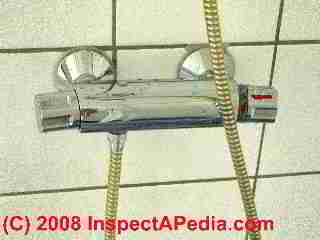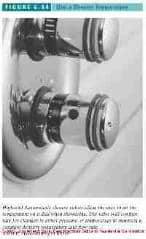 Mixing Valves & Anti Scald Valves for Hot Water
Mixing Valves & Anti Scald Valves for Hot Water
- POST a QUESTION or COMMENT about choosing and installing anti scald devices on building plumbing and heating systems
Anti-Scald valve best practices guide:
This article series explains what a mixing valve, tempering valve, or anti-scald valve is, where and why these valves are installed on hot water systems, and how they work.
This article series answers most questions about Heating System Boiler Controls on central heating systems to aid in troubleshooting, inspection, diagnosis, and repairs.
InspectAPedia tolerates no conflicts of interest. We have no relationship with advertisers, products, or services discussed at this website.
Best Practices Guide to Scald Protection for Bathrooms, Tubs, Showers
Our home page for anti scald devices used in plumbing systems is MIXING / ANTI-SCALD VALVES.
The article below, MIX VALVE SCALD PROTECTION, Best Practices, includes excerpts or adaptations from Chapter 6 of Best Practices Guide to Residential Construction (Steve Bliss, J Wiley & Sons) , courtesy of Wiley & Sons and written by Steven Bliss.
Watch out: it can be confusing listening to plumbers, home inspectors, and building supply sales staff who toss around terms like "mixing valve", "tempering valve", and "pressure-balancing valve" a bit loosely, all referring to ways to avoid scalding burns at plumbing fixtures, but not all working the same way.
A child exposed to 140°F water for as little as three seconds can sustain a third-degree burn requiring hospitalization and skin grafts. Although most scald burns occur in the kitchen, according to the Consumer Product Safety Commission, the most severe scald burns are caused by water flowing into the tub or shower. In response, many state and local codes now require antiscald protection in residential tubs and showers.
Many organizations advocate setting water heaters to no more than 120°F, which gives bathers significantly more time to move away or adjust the temperature before a burn occurs. While this strategy is helpful, it is not always reliable and can cause other problems:
- Noncompliance: many homeowners turn the thermostats up to increase supply.
- Water heater thermostats are often inaccurate. The ANSI standard for gas water heaters allows the temperature to vary by plus-or-minus 10°F.
- Stacking effect: water at the top of a gas water heater can exceed the set point by as much as 30°F.
Article contents
- ANTI SCALD VALVE PROTECTION, Best Practices
- Water Pressure-Balancing Valves
- Thermostatic Mixing Valves
- Retrofits to Avoid Scalding Burns
- Best Practices Guide to Hot Water Fixture Scald Protection
- Use of Point of Supply Water Pressure-Balancing Valves to Control Temperature & Avoid Scalding
- Use of Point of Supply or Point of Use Thermostatic Mixing Valves to Avoid Scalding Burns
There are several approaches to controlling hot water temperature to avoid scalding burns:
- The high temperature limit control on the water heating device itself can be set to prevent scalding water from being produced. Below
at Table of Scalding Temperatures & Times we include a photo of a typical water heater label warning about scalding temperatures, implying that this option is one to consider. - A point of supply pressure balancing valve or automatic mixing valve (or a manual mixing valve) can be installed at or near the water heater, or at the tankless coil or other hot water source so that scald protection is provided even if the water heater is set to a high temperature. This approach is sometimes used to obtain more total hot water as we discuss
at Mix Valve Improves Hot Water Quantity and detail
at HOT WATER IMPROVEMENT.
This approach is discussed beginning
at How Anti Scald Valves Work, and further reviewed by Steven Bliss
at Water Pressure-Balancing Valves. - An temperature-sensing thermostatic mixing valve or anti-scald device can be installed at or near the water heating device so that even if the water heater is set to a high temperature (to obtain more total hot water as we discuss
at Mix Valve Improves Hot Water Quantity and
detail at HOT WATER IMPROVEMENT).
This approach is illustrated and explained at Built-in Fixture Anti-Scald Valves and is discussed further by Mr. Bliss
at Thermostatic Mixing Valves.
As noted in Chapter 6 of Best Practices Guide to Residential Construction (Steve Bliss, J Wiley & Sons) :
There are many styles of mixer valves in tubs and showers, but all should have some sort of protection against scalding.
The young and elderly are at greatest risk due to thinner skin and slower reaction times. More than 35,000 children, most under age six, are treated each year in emergency rooms for tap-water scald burns, according to the National Safe Kids Campaign.
Use of Point of Supply Water Pressure-Balancing Valves to Control Temperature & Avoid Scalding
This is the most commonly used point-of-supply approach.
These automatically adjust the water pressure to maintain the mix of hot and cold water to within 2°F to 3°F of where the user set the shower control.
To guard against someone accidentally turning the shower valve to scalding temperatures, these valves typically use a temperature limit stop that prevents the user from turning the shower control past a set point—typically set at or below 120°F.
Use of Point of Point of Use Thermostatic Mixing Valves to Avoid Scalding Burns
Some models of thermostatic mixing valves are more expensive than pressure-balancing valves and not widely used in the United States.
Thermostatic (temperature sensing) anti-scald valves can be installed either inline near the water heater or as part of the shower control. The inline type of valve, also called a tempering valve, adds cold water to the hot water as it leaves the water heater to maintain a constant temperature, set by the installer. These are commonly used with solar water heaters but can also be tied to a conventional water heater.
A check valve is required on the cold water side to prevent backflow, and a hot-water expansion tank is recommended to prevent excessive pressure on the hot water side. The other type of thermostatic valve is built into some high-end showers (Figure 6-54). These allow the user to set the temperature on a dial when showering.
The unit will compensate for changes in either pressure or temperature to maintain a constant delivery temperature and flow rate. If the cold water fails or the tempered water is still too hot for any reason, the unit will shut off the flow.
As with the pressure-balancing valve, the installer sets a temperature limit stop to prevent the user from turning the shower control to scalding temperatures. We further discuss and illustrate this approach as it is installed in a modern bathroom in Molde, Norway
at Built-in Fixture Anti-Scald Valves.
[Click any image or table to see an enlarged version with additional detail, commentary & source citation.]
Retrofits to Avoid Scalding Burns at Plumbing Fixtures
In retrofits, point-of-use devices can be installed by a plumber or homeowner to limit water temperatures to 120°F. These include antiscald showerheads, as well as point-of-use devices that fit into individual plumbing fixtures, such as showerheads and bath and sink faucets.
For example, MemrySafe and ScaldShield (Antiscald Inc.) are inexpensive retrofit devices that reduce the water flow to less than 1/4 gallon per minute when the water temperature at the faucet or showerhead exceeds 120°F. These devices do not regulate temperature or pressure, but do offer protection against serious burns.
For more about kitchen and bath design and installation
see BATH & KITCHEN DESIGN GUIDE
and PLUMBING SYSTEM INSPECT DIAGNOSE REPAIR
Question: odor issues from poultry plant scalding tank
(Dec 3, 2011) Kevin Trapp said:
within our scald tank area, (poulty plant)the area smells bad when in production, also smells on the outside of the factory, any ideas how to control this issue,
Reply:
Kevin I think you're discussing an indoor air quality odor control issue for the poultry plant (whereas at this article we discuss hot water supply system anti-scald devices used for safety to prevent burns).
We publish quite a bit about tracking down odor sources to their exact source at ODORS & SMELLS DIAGNOSIS & CURE ( on this page at Continue reading where you will find an ARTICLE INDEX to RELATED ARTICLES that includes a live link - ), and about indoor air quality at INDOOR AIR IAQ (topic link at page top).
But for your poultry plant, what makes sense is to bring in an industrial hygienist or building scientist who can examine and give advice about the range of topics that all will have to do with the bad smell when the poultry plant scalding tank area is in operation, such as:
- housekeeping procedures around the scalding tank area including cleaning methods, schedule, and cleaners used
- fresh air supply for the poultry plant - including a review of the existing HVAC system. Sometimes simply improving the quantity of fresh air intake and installing a suitable exhaust fan collector and vent system over the scalding area can be enough to make the work area much more pleasant.
...
Continue reading at ANTI-SCALD VALVE INSPECTION or select a topic from the closely-related articles below, or see the complete ARTICLE INDEX.
Or see these
Recommended Articles
- ANTI SCALD VALVES & TEMPERATURE CONTROL / MIXING VALVES - home
- ANTI_SCALD VALVES & HOT WATER QUANTITY
- ANTI-SCALD VALVE INSPECTION
- ANTI SCALD VALVE PROTECTION, Best Practices
- ANTI SCALD VALVE at TANKLESS COIL
- ANTI-SCALD WATER TEMPERATURE CONTROL TYPES
- HOT WATER ANTI-SCALD REGULATIONS
- MANUAL ANTI-SCALD TEMPERING VALVES
- POINT of USE BUILT-IN FIXTURE ANTI-SCALD VALVES
- HOT WATER QUANTITY IMPROVEMENT
- Legionella BACTERIA in WATER HEATERS
- TABLE OF SCALDING TEMPERATURES & TIMES
- WATER HEATER TEMPERATURE TOO COLD or TOO HOT
- THERMOSTATS, WATER HEATER
- WATER HEATER SAFETY
- WATER HEATER TEMPERATURE ADJUSTMENT CONTROLS
Suggested citation for this web page
ANTI SCALD VALVE PROTECTION, Best Practices at InspectApedia.com - online encyclopedia of building & environmental inspection, testing, diagnosis, repair, & problem prevention advice.
Or see this
INDEX to RELATED ARTICLES: ARTICLE INDEX to WATER HEATERS
Or use the SEARCH BOX found below to Ask a Question or Search InspectApedia
Ask a Question or Search InspectApedia
Questions & answers or comments about choosing and installing anti scald devices on building plumbing and heating systems
Try the search box just below, or if you prefer, post a question or comment in the Comments box below and we will respond promptly.
Search the InspectApedia website
Note: appearance of your Comment below may be delayed: if your comment contains an image, photograph, web link, or text that looks to the software as if it might be a web link, your posting will appear after it has been approved by a moderator. Apologies for the delay.
Only one image can be added per comment but you can post as many comments, and therefore images, as you like.
You will not receive a notification when a response to your question has been posted.
Please bookmark this page to make it easy for you to check back for our response.
Our Comment Box is provided by Countable Web Productions countable.ca
Citations & References
In addition to any citations in the article above, a full list is available on request.
- Mark Cramer Inspection Services Mark Cramer, Tampa Florida, Mr. Cramer is a past president of ASHI, the American Society of Home Inspectors and is a Florida home inspector and home inspection educator. Mr. Cramer serves on the ASHI Home Inspection Standards. Contact Mark Cramer at: 727-595-4211 mark@BestTampaInspector.com
- John Cranor [Website: /www.house-whisperer.com ] is an ASHI member and a home inspector (The House Whisperer) is located in Glen Allen, VA 23060. He is also a contributor to InspectApedia.com in several technical areas such as plumbing and appliances (dryer vents). Contact Mr. Cranor at 804-873-8534 or by Email: johncranor@verizon.net
- A.O. Smith water heater safety sticker: 182734-000 Rev.00 observed on the gas fired water heater shown at High Efficiency Gas Water Heaters
- Thanks to reader J.S.A. for discussing hot water mixing valves and which way to turn the valve - July 2010
- Thanks to reader Athena for discussing hot water mixing valves and which way to turn the valve to make water hotter or cooler - October 2010.
- "Domestic Hot Water Scald Burn Lawsuits, The Who, What, When, Why, Where, How", Dr. D. Bynum Jr., Vernon L. Petri, Esq., John T. Myers, paralegal, Seminar and Technical Paper for the 25-28 Oct 98 Annual ASPE Meeting at the Indianapolis Convention Center, Indianapolis IN, websearch 09/21/2010,original source: http://media.wattswater.com/F-H20LS-Reprint.pdf [Large PDF]
- Our recommended books about building & mechanical systems design, inspection, problem diagnosis, and repair, and about indoor environment and IAQ testing, diagnosis, and cleanup are at the InspectAPedia Bookstore. Also see our Book Reviews - InspectAPedia.
- Fuel Oil & Oil Heating Magazine, 3621 Hill Rd., Parsippany, NJ 07054, 973-331-9545
- Domestic and Commercial Oil Burners, Charles H. Burkhardt, McGraw Hill Book Company, New York 3rd Ed 1969.
- National Fuel Gas Code (Z223.1) $16.00 and National Fuel Gas Code Handbook (Z223.2) $47.00 American Gas Association (A.G.A.), 1515 Wilson Boulevard, Arlington, VA 22209 also available from National Fire Protection Association, Batterymarch Park, Quincy, MA 02269. Fundamentals of Gas Appliance Venting and Ventilation, 1985, American Gas Association Laboratories, Engineering Services Department. American Gas Association, 1515 Wilson Boulevard, Arlington, VA 22209. Catalog #XHO585. Reprinted 1989.
- The Steam Book, 1984, Training and Education Department, Fluid Handling Division, ITT [probably out of print, possibly available from several home inspection supply companies] Fuel Oil and Oil Heat Magazine, October 1990, offers an update,
- Principles of Steam Heating, $13.25 includes postage. Fuel oil & Oil Heat Magazine, 389 Passaic Ave., Fairfield, NJ 07004.
- The Lost Art of Steam Heating, Dan Holohan, 516-579-3046 FAX
- Principles of Steam Heating, Dan Holohan, technical editor of Fuel Oil and Oil Heat magazine, 389 Passaic Ave., Fairfield, NJ 07004 ($12.+1.25 postage/handling).
- "Residential Steam Heating Systems", Instructional Technologies Institute, Inc., 145 "D" Grassy Plain St., Bethel, CT 06801 800/227-1663 [home inspection training material] 1987
- "Residential Hydronic (circulating hot water) Heating Systems", Instructional Technologies Institute, Inc., 145 "D" Grassy Plain St., Bethel, CT 06801 800/227-1663 [home inspection training material] 1987
- "Warm Air Heating Systems". Instructional Technologies Institute, Inc., 145 "D" Grassy Plain St., Bethel, CT 06801 800/227-1663 [home inspection training material] 1987
- Heating, Ventilating, and Air Conditioning Volume I, Heating Fundamentals,
- Boilers, Boiler Conversions, James E. Brumbaugh, ISBN 0-672-23389-4 (v. 1) Volume II, Oil, Gas, and Coal Burners, Controls, Ducts, Piping, Valves, James E. Brumbaugh, ISBN 0-672-23390-7 (v. 2) Volume III, Radiant Heating, Water Heaters, Ventilation, Air Conditioning, Heat Pumps, Air Cleaners, James E. Brumbaugh, ISBN 0-672-23383-5 (v. 3) or ISBN 0-672-23380-0 (set) Special Sales Director, Macmillan Publishing Co., 866 Third Ave., New York, NY 10022. Macmillan Publishing Co., NY
- Installation Guide for Residential Hydronic Heating Systems
- Installation Guide #200, The Hydronics Institute, 35 Russo Place, Berkeley Heights, NJ 07922
- The ABC's of Retention Head Oil Burners, National Association of Oil Heat Service Managers, TM 115, National Old Timers' Association of the Energy Industry, PO Box 168, Mineola, NY 11501. (Excellent tips on spotting problems on oil-fired heating equipment. Booklet.)
- In addition to citations & references found in this article, see the research citations given at the end of the related articles found at our suggested
CONTINUE READING or RECOMMENDED ARTICLES.
- Carson, Dunlop & Associates Ltd., 120 Carlton Street Suite 407, Toronto ON M5A 4K2. Tel: (416) 964-9415 1-800-268-7070 Email: info@carsondunlop.com. Alan Carson is a past president of ASHI, the American Society of Home Inspectors.
Thanks to Alan Carson and Bob Dunlop, for permission for InspectAPedia to use text excerpts from The HOME REFERENCE BOOK - the Encyclopedia of Homes and to use illustrations from The ILLUSTRATED HOME .
Carson Dunlop Associates provides extensive home inspection education and report writing material. In gratitude we provide links to tsome Carson Dunlop Associates products and services.



